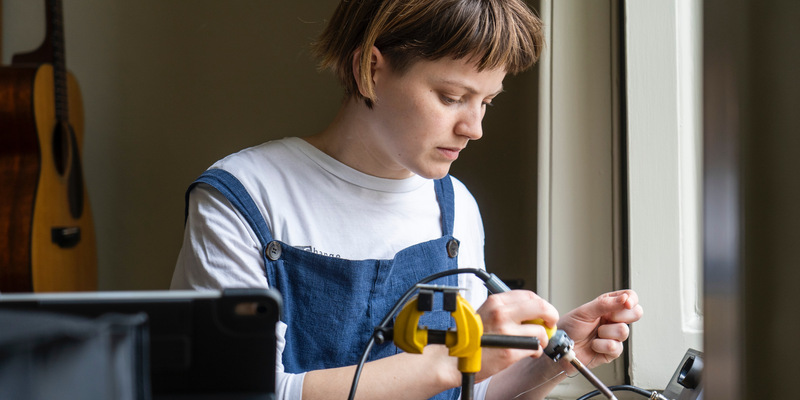5 ways to create a culture of focus (and protect your team from distraction)

Helping remote working teams find focus: How businesses can support their talent to get more done and feel good doing it through deep work.
G L
By Georgie Lavin
•
Nov 11, 2022
Whether your team works remotely or is edging its way back to office life, distraction is known to be a huge barrier to productivity. Many of the biggest distractions are down to the individual (smartphone use, web searching and gossiping, for example).
But many others are cultural, and can be banished when you shape a deep-working culture.
Now that the office worker's working arrangements are to some extent up for grabs, the question of culture looms large. How can you create an environment where you know what's going on, but your people are able to focus and do real deep work?
Here are some ideas, based in solid psychology and business research…
How can you create an environment where you know what's going on, but your people are able to focus and do real deep work?
1. Reject 'always on' attitudes
In his book Deep Work, Cal Newport recommends a shutdown ritual at the end of the day – his is to review his task lists, queue up priorities for the next day, and then declare aloud: "Shutdown complete!".
Newport says that winding down the brain in this way after a day's work is a vital component not only to a stress-reduced life, but also to greater productivity and the ability to think critically.
Expecting your people to be 'always on' will only serve to accelerate the onset of burnout and drive good people to leave your staff roster.
It's also been shown to be bad for business. In the book Sleeping With Your Smartphone, Harvard business professor Leslie A Perlow documents an experiment at the Boston Consulting Group. The experiment found that by creating a culture of 'predictable time off', productivity went up by 20%, with no impact on client satisfaction.
The PTO model is now part of culture at BCG, and the CEO says it improves "client value delivery, consultant development, business services team effectiveness, and overall case experience".
Give your people predictable time off and respect work-life boundaries. They'll be healthier and better as a result.
2. Minimise meetings
Meetings are exhausting, and for remote teams, video meetings have been shown to be a particular drain on energies. So why do we do it?
A drive to minimise meetings requires some work in the background.
Clear (and focused) priorities for the business and for individuals
A master document that captures everything that's going on, and that everyone can access and update
Realistic timelines (and someone to police them)
Getting this in place is a good idea regardless of Zoom fatigue, but once you're organised, you can minimise meetings to need-to-know updates, blocker removal, and decision-making sessions.
At FLOWN, the exec team is experimenting with front-loading meetings into Monday, to give us the rest of the week to actually do the work. We also practise 'deep work Fridays': we close off the week with a meeting-free day so everybody can get elongated periods to focus.
We also try to ask ourselves as often as possible: "can this be discussed asynchronously?"
3. Have clear, documented ways of working
Asynchronous discussion and a lean approach to meetings demands structured ways of working. Making decisions via Slack is dangerous. Equally, big in-person meetings with no clear goal is a waste of time.
Start by making clear how to communicate.
What is Slack (or whatever other IM tool you use) for in your business? And what is it definitely NOT for?
When is it OK to use IM, and when should you pick up the phone or call a meeting or send an email?
Who is signing off on who's work and how do you submit work for review?
Another thing we do at FLOWN is encourage people to set their Slack status helpfully – this communicates when somebody is deep into a project and when they'll come up for air, and if they're away, when they'll be back.
4. Schedule distraction time
If this one sounds a bit too 'organised fun' for you, hear me out. Studies have shown that intentional daydreaming is far less damaging to concentration and focus than spontaneous daydreaming.
This is what Cal Newport means when he says:
"Don't take breaks from distraction. Instead take breaks from focus."
How can you facilitate that in your culture?
Organised fun or not, scheduling time for play as a team is a proven way enhance productivity – one study found that 45 minutes of video game play as a team improved the team's performance by 20% on a subsequent task.
On the daydreaming front – it could be something to try yourself, and in your teams. Try starting big meetings with a chance to breathe and slow down. Schedule team journalling sessions. And in your own work time, schedule time to let your mind wander. Observe how it affects your ability to keep on task the rest of the time.
If it works, evangelise internally and make it part of your culture.
5. Don't distract them!
This one is surprisingly hard to implement… and it involves you, as the leader of the team, to buy into a culture of focus.
What will you do when a project pings into your head and you really want to know how it's going? Or you've had a great idea and you just have to tell your marketing or PR or customer service leader about it?
Breathe. Step away from Slack for just a sec.
Ask yourself: Can this request wait until the next update meeting?
Is there somewhere you can capture your idea? For example your notebook, or better still, a centralised place for ideas that gets reviewed regularly?
If the boss encourages deep work and then pings you when you've set your Teams status as 'Focusing', it removes any impact of the 'Focusing' status. And it'll make it more OK for your team to bother each other, regardless of their declared status. Progress: undone.
Create your own distraction-free workplace
Of course, all this is very easily said, and as with everything we do at FLOWN – it's a journey to go on, not an easy-to-reach destination. But you've got to start the journey to reap the benefits.
This post covers some of the strategies we use here at FLOWN. We love talking about deep work, writing about deep work, and designing products about deep work. But most of we we all love DOING deep work. It makes for a happier team, and gets us better outcomes.
How do you encourage deep work in your company?



















